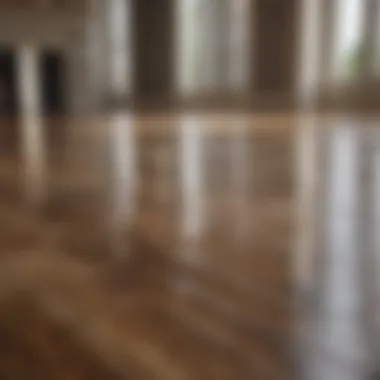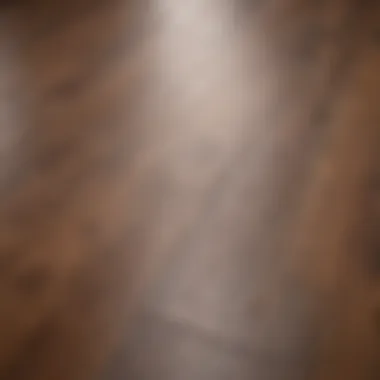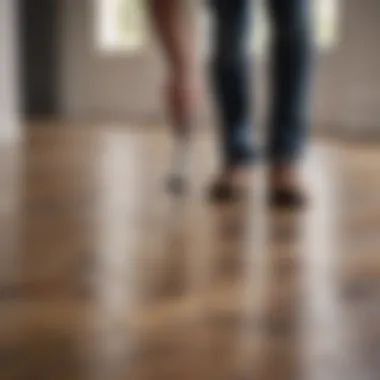Can I Polish Laminate Floors? Complete Guide


Intro
Laminate flooring has surged in popularity over the years, thanks in no small part to its affordability and convenience. While it mimics the appearance of hardwood or stone, the maintenance routines it demands can sometimes leave homeowners scratching their heads. One common question that arises is, "Can I polish laminate floors?" It's a legitimate inquiry, especially for anyone striving to keep their home looking pristine.
Polishing is often seen as a quick fix to revive dull surfaces and to create that eye-catching gleam found on natural wood or tile. However, laminate floors aren't quite the same beast. Understanding the nature of laminate—composed of layers, including a core, decorative layer, and a protective wear layer—can play a crucial role in determining whether polishing is beneficial or even appropriate.
This guide aims to traverse through this terrain, separating facts from fiction, and providing you with comprehensive insights about maintaining laminate flooring while avoiding common traps that many stumble into. By the end of this article, you'll be well-equipped to take informed steps in managing your laminate floors, ensuring they remain an asset to your home.
Understanding Laminate Flooring
When it comes to flooring options, laminate is a choice that many homeowners and renters consider. Understanding laminate flooring is crucial, particularly for those who want both aesthetic appeal and practical performance. This section delves into what laminate flooring truly is, its constituents, the benefits it offers, and where it is frequently applied. As we unravel these elements, it'll become clearer why this topic is pertinent—especially in discussions surrounding maintenance and care, including the often-posed question: can these surfaces be polished?
Definition of Laminate Flooring
At its core, laminate flooring is not solid wood nor traditional vinyl, but rather a composite material. It comprises multiple layers that are fused together, often topped with a transparent, protective layer. This is typically made from high-density fiberboard and is designed to replicate the appearance of wood, stone, or other materials without the hefty price tag. Unlike solid wood, laminate is not cut from trees but manufactured, which allows for a wider variety of styles and appearances.
Composition of Laminate Flooring
The making of laminate flooring is like crafting a layered cake. The bottom layer serves as a moisture barrier, ensuring that the rest of the materials stay intact. Above that, a core layer provides durability, usually crafted from high-density fiberboard. Next, there’s the design layer that displays the desired pattern or color, and finally, a transparent wear layer protects against scratches, stains, and fading. Each of these layers plays a pivotal role in enhancing both the longevity and appearance of the flooring.
Benefits of Laminate Flooring
Choosing laminate flooring brings with it a host of advantages:
- Cost-effectiveness: Generally more affordable compared to hardwood or tile, laminate is an economical option for refreshing interiors.
- Variety: With a wide range of styles and finishes, it's easy to find something that suits your taste.
- Durability: The wear layer protects against the daily rigors of life, making it resistant to scratches and dents.
- Easy Maintenance: Cleaning laminate floors usually requires little more than a damp mop, making it user-friendly.
- Installation: Often designed for DIY enthusiasts, many laminate products come with click-lock systems which simplify the installation process.
These attributes contribute decisively to its popularity among homeowners looking for practical yet stylish flooring solutions.
Common Uses of Laminate Flooring
Laminate flooring isn’t limited to residential spaces; it finds its place in numerous settings. Here are some typical applications:
- Living Rooms: Its aesthetic appeal and comfort make it a favored choice for relaxation spaces.
- Kitchens: Careful selection of moisture-resistant laminate can score you an attractive kitchen floor without the upkeep required by natural surfaces.
- Offices: Its durability and easy maintenance make it an excellent flooring option for commercial settings as well.
- Bedrooms: With its cozy feel underfoot, laminate often transitions smoothly into private spaces.
- Retail Spaces: The versatility and ease of installation makes it a practical choice for businesses looking to create inviting environments.
By understanding these facets of laminate flooring, readers gain insight into not just its value as a flooring option, but also its role in overall home maintenance and care, especially when it comes to decisions surrounding polishing and preserving its appearance. Embracing this knowledge equips homeowners with the tools to make informed choices about maintaining their spaces.
Polishing Laminate Floors: A Viable Option?


When it comes to the maintenance of laminate floors, homeowners often ponder whether polishing is a good option or not. This section dives into the relevance of polishing laminate floors, focusing on its process, risks, recommendations from manufacturers, and insights from experts. Understanding these elements is crucial for ensuring that your floor remains not just aesthetically pleasing, but also retains its durability over time.
Analysis of the Polishing Process
The polishing process for laminate flooring involves the application of a specific product designed to enhance shine and remove minor scuffs and dullness. Typically, this requires the use of a low-speed buffer along with a suitable polishing compound. Many opt for traditional products aimed at hard surfaces, but one must understand that laminate has its own set of requirements. To begin, it's fundamental to first prepare the area by thoroughly cleaning the floor to eliminate dirt and debris.
Here’s how the polishing process generally works:
- Cleaning the floor: Use a microfiber mop to ensure all particles are removed.
- Choosing the right product: Look for products that specify compatibility with laminate. Not every polish will do the trick.
- Applying polish: Use a buffer or a soft cloth to apply the polish in even strokes.
- Drying: Allow for the polish to dry completely before walking on it.
Taking these steps can yield results that make the laminate floors gleam like new.
Potential Risks of Polishing
While some benefits are apparent, the notion of polishing laminate floors isn’t without its perils. One of the main risks is the potential for damage. Using the wrong product or technique can lead to peeling, discoloration, or a haze left on the surface. It’s vital to consider these risk factors:
- Product incompatibility: Using sealers or wax not designed for laminate can create a build-up that worsens the floor’s appearance.
- Moisture exposure: If too much moisture is introduced during the process, it could warp the fiberboard under the laminate layer.
- Surface scratch: An abrasive polish can scratch the protective top layer.
Homeowners should weigh these dangers before deciding to polish.
Manufacturer Recommendations
It's prudent to check the recommendations provided by the laminate flooring manufacturer. Many producers discourage polishing, primarily to prevent potential damage that can arise from user errors. For instance, manufacturers like Pergo and Shaw Floors often advise against using wax or polish, citing the risk of creating a film that can trap dirt and debris. Instead, they suggest:
- Regular cleaning: Mopping with a damp cloth and gentle cleaners intended for laminate.
- Avoiding excess water: A slightly damp mop is advised, as too much water can seep into seams.
Referencing these guidelines is pivotal for maintaining the warranty and longevity of your floor.
Expert Opinions on Polishing
Experts in the field of interior design and flooring also share a critical perspective on the topic of polishing laminate surfaces. Many agree that while a high-gloss finish can enhance the appearance of the flooring temporarily, the risks often outweigh the rewards. A consensus among some interior designers is:
"Polishing tends to mask the issues rather than solving them. A bright shine may look appealing, but it often invites the risk of long-term damage."
Instead, experts typically recommend keeping the focus on appropriate cleaning methods and preventative measures. The idea is to preserve its appearance through correct care rather than rely on polishing, which may only be a quick fix.
Understanding these perspectives provides valuable insight for homeowners contemplating the care and longevity of their laminate flooring.
Alternative Maintenance Techniques


When it comes to keeping laminate floors looking their best, polishing is often a topic of contention. Yet, there are myriad alternative maintenance techniques that can preserve the floor’s appearance and extend its longevity. These methods address specific needs such as cleaning, protection, and preventing damage, each of which plays a crucial role in a home’s aesthetic and functional value.
Cleaning Tips for Laminate Floors
Cleaning laminate floors is not just about removing dirt and dust. It requires a gentle touch to avoid scratching or damaging the surface. Here are some tips to keep in mind:
- Use a Microfiber Mop: Employing a microfiber mop helps in capturing dirt without leaving scratches.
- Sweep Regularly: It’s imperative to regularly sweep the floor to prevent grit build-up, which can lead to scratching.
- Avoid Excess Water: Laminate floors do not respond well to excessive moisture. Use a damp mop, but make sure to wring it out well.
- Tackle Spills Quickly: When liquids spill, wipe them up promptly to avoid staining or warping.
Good maintenance starts with a clean surface. A simple but effective cleaner that is pH balanced can work wonders. Homeowners should remember—this isn’t a one-and-done scenario. Regular cleaning is vital for lasting beauty.
Using Sealants and Finishes
Although sealing laminate floors is not as commonplace as it is with hardwood, there are products that can act as a protective layer. Consider these points:
- Choose the Right Sealant: Look for sealants designed specifically for laminate. These add a layer of defense against moisture and stains.
- Application Process: Applying a sealant can be more involved than other methods, requiring a clean surface and careful application.
- Longevity: Proper application can help in extending the life of the laminate and maintaining its sheen. Touch-ups might be necessary every couple of years, depending on traffic and wear.
Applying a sealant not only enhances appearance but also reinforces the floor against unforeseen damage.
Preventing Damage to Laminate Surfaces
Taking preventative measures can save homeowners from future headaches. Some essential tips include:
- Use Furniture Pads: To avoid scratches from furniture, always place protective pads under heavy items.
- Maintain Consistent Humidity: Extreme fluctuations in humidity can cause laminate to expand or contract. Keeping humidity levels stable can prevent warping.
- Avoid High-Heel Shoes: If possible, guests should be informed to leave high heels off the laminate. These can create deep impressions.
- Place Rugs Strategically: Use area rugs in high-traffic areas to absorb impact and reduce wear.
Keeping laminate surfaces free from damage isn’t just about immediate fixes; it’s a long-term strategy that goes a long way.
Selecting the Right Cleaning Products
The market is awash with cleaning products, but not all are suitable for laminate floors. Here's how to choose wisely:
- Check Labels: Opt for cleaners that specify they are safe for laminate flooring. It’s worth scrutinizing the ingredients to avoid harsh chemicals that could harm the floor.
- Natural Options: Sometimes, natural cleaners such as vinegar diluted with water can do the trick without risking damage.
- Avoid Wax and Oil-Based Products: These can leave residues on laminate, making it look dull and attracting dirt more readily.
Understanding what cleaning agents to use— or avoid— while caring for laminate floors can make a significant impact.
In summary, effective maintenance of laminate flooring involves an array of techniques beyond simple polishing. Each method—cleaning, protecting, preventing damage, and selecting the right products— contributes to the overall upkeep of your floors, making it so you can enjoy them for years to come.
Laminate Floor Restoration Options
When discussing the longevity and upkeep of laminate flooring, the topic of restoration naturally comes into play. Restoration options can breathe new life into floors that have seen better days. While laminate is known for its resilience, it is not immune to scratches, wear, and tear. Knowing when and how to move forward with restoration is crucial for maintaining the aesthetic of a home. Here, I’ll cover the essential elements to consider about laminate floor restoration, the benefits it brings, and the various methods available.


When to Consider Restoration
Recognizing the right moment for laminate floor restoration can be tricky. Some indicators that it might be time to consider such measures include:
- Visible Damage: If you notice scratches, dents, or fading in specific areas, this might signal that restoration is necessary.
- Persistent Stains: Stains that won’t budge no matter how much you clean can make a space look aged and unkempt.
- Decreased Shine: Over time, laminate can lose its luster, appearing dull even after cleaning.
- Water Damage: Moisture can warp laminate, leading to separations at the seams.
"A proactive approach may save you from larger issues down the road. Don't let small problems snowball into bigger headaches."
Addressing these concerns early on can help to preserve your investment and maintain the charm of your space. Ignoring signs of wear can lead to more extensive damage, often requiring costly replacements.
Professional Restoration Services
While some homeowners may opt for a DIY approach, there's certainly value in hiring professionals for laminate floor restoration. These services bring expertise that can assure a high-quality outcome. Here are some factors to consider for enlisting professional help:
- Experience with Laminate: Professionals are accustomed to dealing with a variety of surfaces, knowing precisely how to handle challenges that arise during treatment.
- Specialized Tools: Certain jobs may need tools that are not typically found in a homeowner’s toolkit. Professionals come equipped to handle many scenarios.
- Time Efficiency: Many home restoration projects can be time-consuming, taking longer than expected. Professionals often complete them more swiftly, allowing homeowners to resume their daily routines.
- Guaranteed Work: Utilizing skilled services might provide warranties, ensuring that any issues can be rectified without additional costs.
DIY Restoration Methods
If you're keen on rolling up your sleeves, there are several do-it-yourself methods for restoring your laminate floors, making it an affordable approach, provided caution is exercised. Here are a few strategies for the ambitious homeowner:
- Deep Cleaning: Use a suitable laminate floor cleaner to remove built-up grime and restore shine. Combining vinegar and water can provide a natural option for maintenance, keeping floors fresh without harmful chemicals.
- Scratch Repair: Minor scratches can be camouflaged using a marker labelled specifically for laminate flooring, or try filling in deeper scratches with wood filler that matches the laminate's color.
- Re-sealing: If your laminate allows for it, applying a thin layer of appropriate sealant can protect against future scratches and spills.
- Floor Polish: There are specially formulated polishes designed for laminate flooring, which can help in restoring the surface’s shine. Always check the manufacturer’s guidelines before usage.
Overall, knowing how and when to pursue restoration, whether through professionals or DIY methods, can go a long way in prolonging the life of your laminate floors and saving you money in the long haul.
Finales on Polishing Laminate Floors
When it comes to understanding the nuances of laminate flooring maintenance, the conclusions drawn regarding polishing are critically important. This section wraps up the essential insights gathered throughout the article, giving homeowners a clear perspective on whether polishing is a feasible option for their needs. It’s not just about aesthetics; it’s about the health of the flooring and the longevity of the investment.
Summary of Key Findings
In reviewing the content of the previous sections, we find several key takeaways:
- Polishing is generally not recommended for laminate flooring. While it might seem like an easy way to restore shine, the process could lead to a host of issues, such as dulling the surface or possibly causing damage.
- Alternatives like proper cleaning and maintenance are far more effective for preserving the look and integrity of laminate floors. Regular sweeping and using damp mops can keep surfaces looking fresh without risking harm.
- Understanding the finish and manufacturer’s guidelines is paramount. Each laminate product can have specific instructions on cleaning and maintenance, which plasters a foundation for decision-making.
- Cost-effective solutions exist, such as using seals or finishes specially designed for laminate that might enhance durability without the drawbacks of polishing.
Importantly, this guide has also debunked some sedimentations about laminate care, emphasizing that it is indeed a resilient flooring option even without polishing.
Final Recommendations for Homeowners
When deciding how to approach the care of laminate floors, homeowners should consider the following recommendations:
- Avoid polishing. Instead, focus on cleaning and the occasional treatment with laminate-friendly products.
- Invest in routine maintenance tools like soft-bristle brooms and microfiber cloths, which can effectively eliminate dirt without scratching.
- If you notice wear, instead of opting for a polish, explore options for professional restoration or even DIY methods to refinish the surfaces.
- Stay informed about your specific flooring type and its properties. Manufacturers often provide valuable insights on what works best for their products.
"A stitch in time saves nine." This age-old adage rings true when it comes to laminate flooring. Taking proactive, informed steps is crucial in ensuring your flooring stands up beautifully to the test of time.
Ultimately, knowledge is power. Homeowners are encouraged to fully grasp the basics of laminate maintenance, ensuring decisions are made with confidence, ultimately enhancing the longevity and beauty of their spaces.







